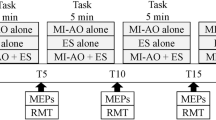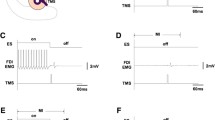Abstract
Motor imagery can be defined as the covert rehearsal of movement. Previous research with transcranial magnetic stimulation (TMS) has demonstrated that motor imagery increases the corticospinal excitability of the primary motor cortex in the area corresponding to the representation of the muscle involved in the imagined movement. This research, however, has been limited to imagery of oneself in motion. We extend the TMS research by contrasting first person imagery and third person imagery of index finger abduction-adduction movements. Motor evoked potentials were recorded from first dorsal interosseous (FDI) and abductor digiti minimi (ADM) during single pulse TMS. Participants performed first and third person motor imagery, visual imagery, and static imagery. Visual imagery involved non biological motion while static imagery involved a first person perspective of the unmoving hand. Relative to static imagery, excitability during imagined movement increased in FDI but not ADM. The facilitation in first person imagery adds to previous findings. A greater facilitation of MEPs recorded from FDI was found in third person imagery where the action was clearly attributable to another person. We interpret this novel result in the context of observed action and imagined observation of self action, and attribute the result to activation of mirror systems for matching the imagined action with an inner visuo-motor template.




Similar content being viewed by others
References
Annett J (1995) Motor imagery: perception or action?. Neuropsychologia 33:1395–1417
Bandura A (1989) Human agency in social cognitive theory. Am Psychol 44:1175–1184
Binder JR, Frost JA, Hammeke TA, Bellgowan PSF, Rao SM, Cox RW (1999) Conceptual processing during the conscious resting state: a functional MRI study. J Cogn Neurosci 11:80–93
Binkofski F, Amunts K, Stephan KM, Posse S, Schormann T, Freund H, Zilles K, Seitz RJ (2000) Broca’s region subserves imagery of motion: a combined cytoarchitectonic and fMRI study. Hum Brain Mapp 11:273–285
Briggs GG, Nebes RD (1975) Patterns of hand preference in a student population. Cortex 11:230–238
Callow N, Hardy L (2004) The relationship between the use of kinaesthetic imagery and different visual imagery perspectives. J Sports Sci 22:167–177
Chen R, Classen J, Gerloff C, Celnik P, Wassermann EM, Hallet M, Cohen LG (1997) Depression of motor cortex excitability by low-frequency transcranial magnetic stimulation. Neurology 48:1398–1403
Clark S, Tremblay F, Ste-Marie D (2004) Differential modulation of corticospinal excitability during observation, mental imagery and imitation of hand actions. Neuropsychologia 42:105–112
Decety J (1996) Do imagined and executed actions share the same neural substrate?. Brain Res Cogn Brain Res 3:87–93
Facchini S, Muellbacher W, Battaglia F, Boroojerdi B, Hallet M (2002) Focal enhancement of motor cortex excitability during motor imagery: a transcranial magnetic stimulation study. Acta Neurol Scand 105:146–151
Fadiga L, Fogassi L, Pavesi G, Rizzolatti G (1995) Motor facilitation during action observation: a magnetic stimulation study. J Neurophysiol 73:2608–2611
Fadiga L, Buccino G, Craighero L, Fogassi L, Gallese V, Pavesi G (1999) Corticospinal excitability is specifically modulated by motor imagery: a magnetic stimulation study. Neuropsychologia 37:147–158
Farrer C, Frith CD (2002) Experiencing oneself vs another person as being the cause of an action: the neural correlates of the experience of agency. NeuroImage 15:596–603
Féry Y (2003) Differentiating visual and kinesthetic imagery in mental practice. Can J Exp Psychol 57:1–10
Gallese V, Fadiga L, Fogassi L, Rizzolatti G (1996) Action recognition in the premotor cortex. Brain 119:593–609
Gangitano M, Mottaghy FM, Pascual-Leone A (2001) Phase-specific modulation of cortical motor output during movement observation. NeuroReport 12:1489–1492
Goss S, Hall C, Buckolz E, Fishburne G (1986) Imagery ability and the acquisition and retention of movements. Mem Cogn 14:469–477
Grèzes J, Decety J (2001) Functional anatomy of execution, mental simulation, observation, and verb generations of actions: a meta-analysis. Hum Brain Mapp 12:1–19
Hardy L (1997) The Coleman Roberts Griffith address: three myths about applied consultancy work. J Appl Sport Psychol 9:277–294
Hardy L, Callow N (1999) Efficacy of external and internal visual imagery perspectives for the enhancement of performance on tasks in which form is important. J Sport Exerc Psychol 21:95–112
Hari R, Forss N, Avikainen S, Kirveskari E, Salenius S, Rizzolatti G (1998) Activation of human primary motor cortex during action observation: a neuromagnetic study. Proc Natl Acad Sci USA 95:15061–15065
Harris DV, Robinson WJ (1986) The effects of skill level on EMG activity during internal and external imagery. J Sport Psychol 8:105–11
Hashimoto R, Rothwell JC (1999) Dynamic changes in corticospinal excitability during motor imagery. Exp Brain Res 125:75–81
Housner L, Hoffman SJ (1981) Imagery ability in recall of distance and location information. J Mot Behav 13:207–223
Isaac AR, Marks DF (1995) Individual differences in mental imagery experience: developmental changes and specialization. Br J Psychol 85:479–500
Jack AI, Roepstorff A (2002) Introspection and cognitive brain mapping: from stimulus-response to script-report. Trends Cogn Sci 6:333–339
Jeannerod M (1994) The representing brain: neural correlates of motor intention and imagery. Behav Brain Sci 17:187–245
Kasai T, Kawai S, Kawanishi M, Yagahi S (1997) Evidence for facilitation of motor evoked potentials (MEPs) induced by motor imagery. Brain Res 744:147–150
Lafleur MF, Jackson PL, Malouin F, Richards CL, Evans AC, Doyon J (2002) Motor learning produces parallel dynamic functional changes during the execution and imagination of sequential foot movements. NeuroImage 16:142–157
Li CR (2000) Impairment of motor imagery in putamen lesions in humans. Neurosci Lett 287:13–16
Lotze M, Montoya P, Erb M, Hülsmann E, Flor H, Klose U, Birbaumer N, Grodd W (1999) Activation of cortical and cerebellar motor areas during executed and imagined hand movements: an fMRI study. J Cogn Neurosci 11:491–501
Luft AR, Skalej M, Stefanou A, Klose U, Voigt K (1998) Comparing motion- and imagery- related activation in the human cerebellum: a functional MRI study. Hum Brain Mapp 6:105–113
Mazoyer B, Zago L, Mellet E, Bricogne S, Etard O, Houdé O, Crivello F, Joliot M, Petit L, Tzourio-Mazoyer N (2001) Cortical networks for working memory and executive functions sustain the conscious resting state in man. Brain Res Bull 54:287–298
Merchant H, Battaglia-Mayer A, Georgopoulos AP (2001) Effects of optic flow in motor cortex and area 7a. J Neurophysiol 86:1937–1954
Merchant H, Battaglia-Mayer A, Georgopoulos AP (2004) Neural responses during interception of real and apparent circularly moving stimuli in motor cortex and area 7a. Cereb Cortex 14:314–331
Merchant H, Battaglia-Mayer A, Georgopoulos AP (2004) Neural responses in motor cortex and area 7a to real and apparent motion. Exp Brain Res 154:291–307
Murphy S (1994) Imagery interventions in sport. Med Sci Sports Exerc 26:486–493
Naito E, Kochiyama T, Kitada R, Nakamura S, Matsumura M, Yonekura Y, Sadato N (2002) Internally simulated movement sensations during motor imagery activate cortical motor areas and the cerebellum. J Neurosci 22:3683–3691
Ogiso T, Kobayashi K, Sugishita M (2000) The precuneus in motor imagery: a magnetoencephalographic study. NeuroReport 11:1345–1349
Osborne J (2002) Notes on the use of data transformations. Pract Assess Res Eval 8: http://PAREonline.net/getvn.asp?v=8&n=6
Pascual-Leone A, Grafman J, Hallet M (1994) Modulation of cortical motor output maps during development of implicit and explicit knowledge. Science 263:1287–1289
Patuzzo S, Fiaschi A, Manganotti P (2003) Modulation of motor cortex excitability in the left hemisphere during action observation: a single- and paired-pulse transcranial magnetic stimulations study of self- and non-self-action observation. Neuropsychologia 41:1272–1278
Porro CA, Francescato MP, Cettolo V, Diamond ME, Baraldi P, Zuiani C, Mazzocchi M, di Prampero PE (1996) Primary motor and sensory cortex activation during motor performance and motor imagery: a functional magnetic resonance imaging study. J Neurosci 16:7688–7698
Rossini PM, Rossi S, Pasqualetti P, Tecchio F (1999) Corticospinal excitability modulation to hand muscles during movement imagery. Cereb Cortex 9:161–167
Roth M, Decety J, Raybaudi M, Massarelli R, Delon-Martin C, Segebarth C, Morand S, Gemignani A, Décorps M, Jeannerod M (1996) Possible involvement of primary motor cortex in mentally simulated movement: a functional magnetic resonance imaging study. NeuroReport 7:1280–1284
Ruby P, Decety J (2001) Effect of subjective perspective taking during simulation of action: a PET investigation of agency. Nat Neurosci 4:546–550
Schnitzler A, Salenius S, Salamin R, Jousmäki V, Hari R (1997) Involvement of primary motor cortex in motor imagery: a neuromagnetic study. NeuroImage 6:201–208
Seitz RJ, Stephan KM, Binkofski F (2000) Control of action as mediated by the human frontal lobe. Exp Brain Res 133:71–80
Smyth MM, Waller A (1998) Movement imagery in rock climbing: patterns of interference from visual, spatial and kinaesthetic secondary tasks. Appl Cogn Psychol 12:145–157
Stark CEL, Squire LR (2001) When zero is not zero: the problem of ambiguous baseline conditions in fMRI. Proc Natl Acad Sci USA 98:12760–12766
Start K B, Richardson A (1964) Imagery and mental practice. Br J Educ Psychol 34:280–284
Stephan KM, Fink GR, Passingham RE, Silbersweig D, Ceballos-Baumann AO, Frith CD, Frackowiak RSJ (1995) Functional anatomy of the mental representation of upper extremity movements in healthy subjects. J Neurophysiol 73:373–386
Stinear CM, Byblow WD (2003) Motor imagery of phasic thumb abduction temporally and spatially modulates corticospinal excitability. Clin Neurophysiol 114:909–914
Vealey RS (1986) Imagery training for performance enhancement. In: Williams JM (eds) Applied sport psychology: personal growth to peak performance. Mayfield Publishing, Mountain View California, pp. 209–231
Vogt S (1996) Imagery and perception-action mediation in imitative actions. Brain Res Cogn Brain Res 3:79–86
Wassermann EM (1998) Risk and safety of repetitive transcranial magnetic stimulation: report and suggested guidelines from the international workshop on the safety of repetitive transcranial magnetic stimulation, 5–7 June, 1996. Electroencephalogr Clin Neurophysiol 108:1–16
White A, Hardy L (1995) Use of different imagery perspectives on the learning and performance of different motor skills. Br J Psychol 86:169–80
Yahagi S, Kasai T (1999) Motor evoked potentials induced by motor imagery reveal a functional asymmetry of cortical motor control in left- and right- handed human subjects. Neurosci Lett 276: 185–188
Acknowledgements
This research was supported by grants MIUR 2003 and FIRB 2001 awarded to Salvatore M. Aglioti.
Author information
Authors and Affiliations
Corresponding author
Rights and permissions
About this article
Cite this article
Fourkas, A.D., Avenanti, A., Urgesi, C. et al. Corticospinal facilitation during first and third person imagery. Exp Brain Res 168, 143–151 (2006). https://doi.org/10.1007/s00221-005-0076-0
Received:
Accepted:
Published:
Issue Date:
DOI: https://doi.org/10.1007/s00221-005-0076-0




